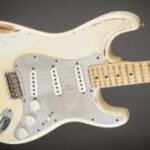Many guitarists, especially when recording at home, wonder if they can use their trusty electric guitar to lay down some bass lines. The idea of saving space, time, and money by avoiding the need for a separate bass guitar is certainly appealing. The question arises: can you effectively make your guitar sound like a bass guitar, particularly with tools like amp modelers and effects processors?
This question isn’t new. Back in the 1980s, with the advent of guitar synthesizers, musicians were already exploring the possibilities of making a guitar sound like other instruments. Guitar legends like John McLaughlin, Al Di Meola, and Pat Metheny even used guitar controllers to drive the sophisticated Synclavier. The dream of transforming a guitar into a versatile instrument capable of mimicking various sounds, including a bass, has been around for decades.
However, the reality is more nuanced. While technology offers tools to lower the pitch of a guitar signal, truly replicating the sound and feel of a bass guitar is challenging. Simply using pitch-shifting effects or octave pedals on a guitar signal, even with amp and cabinet simulations, will not magically turn your guitar into a bass.
One key difference lies in the approach to playing. After years of playing guitar, switching to bass reveals a different world. Bass playing demands a different dynamic, a different rhythmic feel, and a different sonic space within a mix. It’s not just about lower notes; it’s about the role the bass guitar plays in music. Think about the distinct attack, sustain, and overall sonic character of a bass guitar.
Exploring alternatives like octave pedals can be interesting. An octave pedal can certainly drop your guitar’s pitch and create lower frequencies. This can be a fun effect and might even spark new musical ideas. You can experiment with different amp simulations and cabinet impulse responses (IRs) within processors like the Helix to shape the tone further. However, it’s crucial to understand that this is still an effect, a creative tool to explore different sonic territories, rather than a true bass guitar replacement. Experimenting with these tools can be valuable for creativity and home recording scenarios where true bass tones are not critical.
In conclusion, while you can use effects to lower the pitch of your guitar and venture into bass-like frequencies, achieving an authentic bass guitar sound remains a challenge. For serious bass lines, especially in professional recordings or live performances, nothing truly replaces the real deal – a dedicated bass guitar played with a bassist’s touch. However, for basic recording or creative exploration, guitar pitch-shifting and octave effects offer interesting avenues to experiment with lower frequencies and expand your sonic palette.

